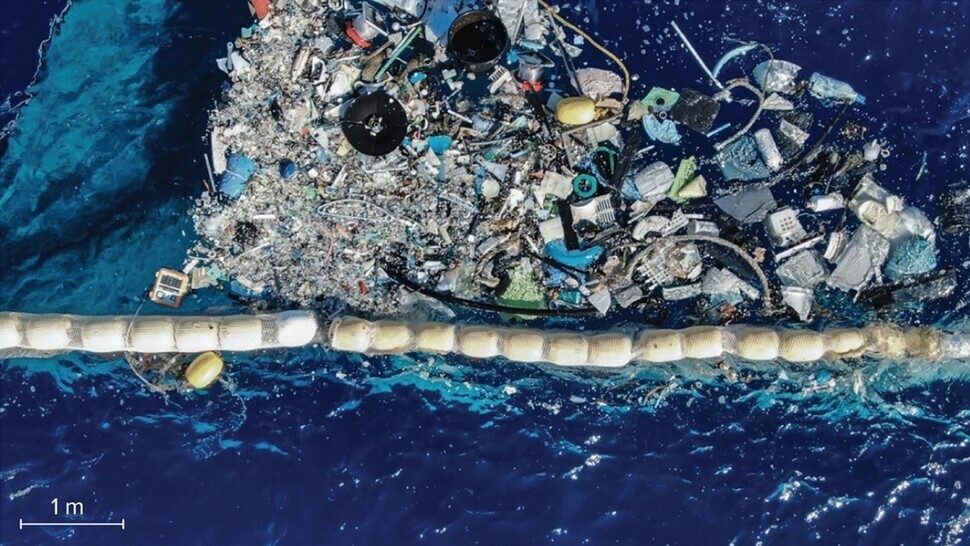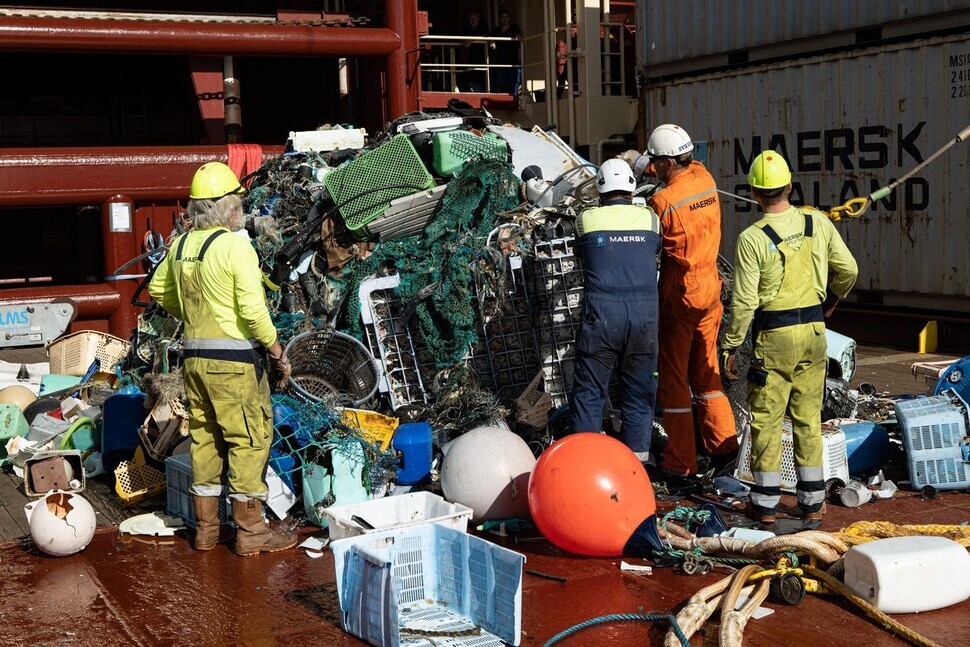hankyoreh
Links to other country sites 다른 나라 사이트 링크
Top contributor to floating garbage island in the Pacific may surprise you

The main origin of the plastic floating in the Great Pacific Garbage Patch (GPGP) is not the everyday waste sent downriver in countries like the Philippines and India but the large-scale fishing activities of Japan, China and South Korea, a new study has found.
The GPGP is a stretch of ocean between Hawaii and North America that is 16 times larger than South Korea. The 79,000 tons of waste, much of it plastic, in the patch is less of an island and more of a thin soup that circulates on ocean currents.
The study traced the origin of 6,000 pieces of plastic trash measuring at least 5cm in diameter that were collected from the GPGP in 2019 by the Ocean Cleanup, a Dutch nonprofit dedicated to developing technology for recovering plastic from the ocean. Clues were found in the language written on the trash, as well as company names, trademarks, logos, addresses and phone numbers.

The findings of the study, which was conducted by a team of researchers led by Laurent Lebreton, an activist with the Ocean Cleanup, were published on Sept. 1 in the scientific journal Scientific Reports.
“While recent assessments for plastic inputs into the ocean point to coastal developing economies and rivers as major contributors into oceanic plastic pollution, here we show that most floating plastics in the North Pacific subtropical gyre can be traced back to five industrialised fishing nations,” the researchers said in the study.
The countries accounting for the largest amount of garbage are Japan (34%) and China (32%), followed by Korea (10%), the US (7%), Taiwan (6%) and Canada (5%). The researchers referred to the Korean Peninsula, lumping together South and North Korea into a single category.
“New findings confirm the oceanic garbage patches cannot be cleaned solely through river interception and highlight the potentially vital role of fishing and aquaculture in ridding the world’s oceans of plastic,” wrote Matthias Egger, a marine scientist with the Ocean Cleanup who took part in this study, in a post on the group’s website.

The countries found to be the primary origins of plastic waste in this study — that is, Japan, China, Korea, the US and Taiwan — carry on much of the world’s industrialized fishing.
The researchers said in the study that the conclusion of their “analysis of hard plastic debris [. . .] is likely also applicable to nets and ropes for which the origin is harder to determine.” Nets and ropes are a major byproduct of fishing activities.
Previously, it was thought that the main source of plastic waste floating in the ocean were riverside and seaside cities in developing countries including the Philippines (36%), India (13%), Malaysia (7%) and China (7%).
That raises the question of why these countries account for such a small share of waste in the Great Pacific Garbage Patch relative to fishing debris.
“Virtual plastic particles released from rivers generally spent a lot of time near the shoreline, with a high chance of beaching close to the river mouth,” Egger said. “Our models suggest that floating plastic debris emitted from fishing activities is potentially two to ten times more likely to reach the GPGP than plastics originating from rivers.”

While one-third of the large plastic items collected from the Pacific Ocean were “unidentifiable,” Egger wrote, “the other two-thirds was dominated by objects typically used in fishing, such as floats, buoys, crates, buckets, baskets, containers, drums, jerry cans, fish boxes, and eel traps.” Among the waste items whose use could be identified, the most common type was oyster farm equipment.
“The oldest identified item was a buoy dating from 1966,” the study said.
According to Egger, most of the trash collected is decades old, showing that “the plastic in these garbage patches persists and can cause harm for lengthy periods, continually degrading into microplastics.”
By Cho Hong-sup, environment correspondent
Please direct questions or comments to [english@hani.co.kr]

Editorial・opinion
![[Guest essay] Preventing Korean Peninsula from becoming front line of new cold war [Guest essay] Preventing Korean Peninsula from becoming front line of new cold war](https://flexible.img.hani.co.kr/flexible/normal/500/300/imgdb/original/2024/0507/7217150679227807.jpg) [Guest essay] Preventing Korean Peninsula from becoming front line of new cold war
[Guest essay] Preventing Korean Peninsula from becoming front line of new cold war![[Column] The state is back — but is it in business? [Column] The state is back — but is it in business?](https://flexible.img.hani.co.kr/flexible/normal/500/300/imgdb/original/2024/0506/8217149564092725.jpg) [Column] The state is back — but is it in business?
[Column] The state is back — but is it in business?- [Column] Life on our Trisolaris
- [Editorial] Penalties for airing allegations against Korea’s first lady endanger free press
- [Editorial] Yoon must halt procurement of SM-3 interceptor missiles
- [Guest essay] Maybe Korea’s rapid population decline is an opportunity, not a crisis
- [Column] Can Yoon steer diplomacy with Russia, China back on track?
- [Column] Season 2 of special prosecutor probe may be coming to Korea soon
- [Column] Park Geun-hye déjà vu in Yoon Suk-yeol
- [Editorial] New weight of N. Korea’s nuclear threats makes dialogue all the more urgent
Most viewed articles
- 1Behind-the-times gender change regulations leave trans Koreans in the lurch
- 2Family that exposed military cover-up of loved one’s death reflect on Marine’s death
- 3Yoon’s revival of civil affairs senior secretary criticized as shield against judicial scrutiny
- 4Japan says its directives were aimed at increasing Line’s security, not pushing Naver buyout
- 5Unexpected rate of AI development requires timely discussion of side effects
- 6[Guest essay] Preventing Korean Peninsula from becoming front line of new cold war
- 7Marines who survived flood that killed colleague urge president to OK special counsel probe
- 8[Guest essay] Maybe Korea’s rapid population decline is an opportunity, not a crisis
- 9S. Korean first lady likely to face questioning by prosecutors over Dior handbag scandal
- 10Is Japan about to snatch control of Line messenger from Korea’s Naver?